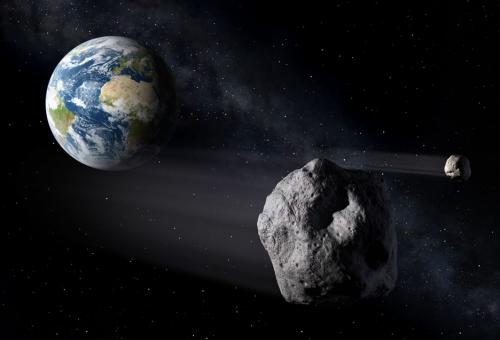Asteroid 2004 BL86 - A Close Encounter
On Monday January 26, 2015 a rather large asteroid will cruise past Earth at quite a close distance. So close, that it will mark the closest pass of an asteroid this size for the next 13 years! Though this passing will be super close, doomsayers are in for a disappointment as no impact threat is imminent. Otherwise, sky watchers are setup for possibly the best visible asteroid pass... ever?
Discovered on January 30, 2004 by the Lincoln Near-Earth Asteroid Research (LINEAR) survey, Asteroid 2004 BL86 is near 0.3 miles in diameter, making it about twice the size of an aircraft carrier. Swinging by Earth at a distance of 745,000 miles (three times the distance of the Moon) and at speeds of 35,057 mph, the asteroid will be easily visible in backyard telescopes and possibly large binoculars. Unlike many Near-Earth Asteroids (NEA), 2004 BL86's close encounter has been known for some time and is surely not a surprise pass.
Viewing the asteroid should be easy. The asteroid's closest point will occur about 11:20 a.m. EST, though visibility will be excellent for U.S. stargazers that night. Passing into the constellation Cancer just after sunset, 2004 BL86 will visibly traverse the constellation Cancer over the course of the night. Additionally, between midnight and 1:00 a.m. EST (Jan 27th), 2004 BL86 will have a visibly close encounter with the fabulous Beehive Star Cluster (Messier 44) in Cancer, passing just to the East of the cluster. This will make it easily identifiable for non-computerized telescopes. Over the course of 10 minutes, the asteroid's visible position in a telescope will chance dramatically, moving almost the diameter of the full Moon among fixed stars. Look for the star that changes position over the course of a minute, that's the asteroid.
Hey, like a naked eye comet (Comet C/2014 Q2 Lovejoy) isn't cool enough. Now we have a Near-Earth Asteroid passing too. If you can't get out on the 26th to catch a view (you know, New England weather?), catch a view online compliments of the Virtual Telescope Project.

- Author:
- Scott MacNeill
- Entry Date:
- Jan 24, 2015
- Published Under:
- Scott MacNeill's Columns


